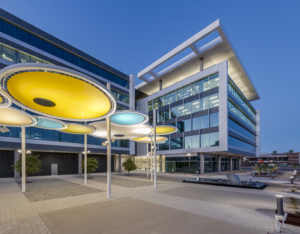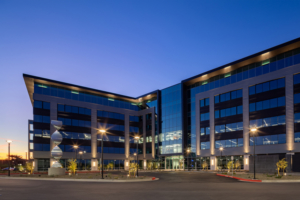Cities along the light rail to benefit from $20M development loan fund, capitalized by Local Initiatives Support Corp. and the Raza Development Fund, to build affordable housing and other sustainable amenities.
Picture this:
You get on Metro light rail at your workplace in Phoenix and disembark in Mesa in front of your favorite organic grocery store. A shaded pedestrian path allows you to walk to your home on the 10th floor of a new apartment tower, which is populated by other working families. On the way you pick up your child at a local charter school.
There’s no car, no gas burned, no miles of driving on asphalt freeways.
Pipe dream? Perhaps not.
This type of urban development — denser, pedestrian-oriented, close to public transportation — may be more possible than you think.
A $20M loan fund for developers aiming to build affordable housing and other amenities along the Metro light rail line should spark activity in the Valley’s nascent urban development market.
Right now, says Mesa Mayor Scott Smith, that market is relatively immature and doesn’t have a critical mass of developers who are willing to risk financing urban projects.
Smith recently joined Tempe Mayor Hugh Hallman and Phoenix Mayor Phil Gordon — both of who have worked to promote transit-oriented development in their light rail cities — to tout the importance of the Sustainable Communities Development Fund.
Capitalized jointly by the Phoenix office of the Local Initiatives Support Corp. and the Raza Development Fund, the fund is expected to grow, hopefully reaching an eventual goal of $50M, says Shannon Scutari, who has been hired as a consultant by Local Initiatives Support Corp.
Scutari is coordinating efforts of the Sustainable Communities Working Group, a coalition of state, local, regional and non-profit organizations that are working to make equitable transit-oriented development a reality.
The coalition is a “signature effort,” Scutari says, a broad-based, intergovernmental, public/private partnership of people who share a goal: fostering sustainable, affordable urban neighborhoods near mass-transit corridors.
It’s new territory, far different than the development that spawned suburban sprawl, with far-flung housing developments connected not by a sense of community or shared-purpose, but by asphalt.
“This is not business as usual,” says Teresa Brice, director of Local Initiatives Support’s Arizona office, “This is something that will require (developers) to do something a little different than build three units per acre.”
Local Initiatives Support Corp. has hired a consultant to do a feasibility study to determine the affordable housing needs along the light rail line.
The study will attempt to determine the capital needs of the development community, assess what each jurisdiction will be able to bring to the table, and determine what the philanthropic sector can contribute.
Finally, Brice says the study will recommend how to structure the fund and create joint underwriting standards to govern it.
But, Brice and Scutari say they already are considering five or six proposals and may go ahead with one or more even if the study is not finished.
The fund will provide seed money or bridge funds that allow a developer to get started on a project.
Funding will not be limited to federal or local definitions of low-income housing. Coalition members will have discretion to examine each neighborhood to determine its needs, she says, whether that is affordable housing, a charter school, a community health center, or a small business.
A proposal submitted by developer Eric Brown seeks funding for a small apartment complex — perhaps nine to 12 units—at Fifth and Roosevelt streets.
Details are still in flux, but Brown says he envisions each unit costing between $600 to $950 a month in rent — well within reach of the commuters, ASU students and other downtown dwellers who use the light rail.
“There’s a lot of positive buzz about urban housing and living in the downtown right now,” says Brown, who is known for his urban developments Artisan Lofts, Artisan Village and Artisan Parkview by Chase Field.
“It takes some expertise — it’s not brain surgery but it does require a developer to understand how an urban person wants to live and what they will need,” Brown says.
And that is a process that is well underway, thanks to the light rail, Mesa’s Smith says.
“This could set the stage and create a foundation for private investors to come in and for the capital markets to adjust and recognize they should cut a check for the types of investment I think will pay off,” Smith says.
Currently the rail line extends only one mile into Mesa, ending just east of Dobson Road. But an extension is planned that will traverse downtown Mesa and end just east of Mesa Drive.
Then, Smith says Mesa hopes to spur the type of redevelopment that Tempe and Phoenix have witnessed along portions of the line. Hallman has credited the light rail for spurring $2.5B in redevelopment along Apache Boulevard.
“Individual projects in individual cities create a patchwork quilt of development,” Scutari says. “This is really a push for a regional policy approach” to development along the light rail. “This is the connective tissue for the corridor.”
For more information about the Local Initiatives Support Corp. and the Raza Development Fund, visit www.lisc.org or www.razafund.org.
AZRE Magazine September/October 2011



